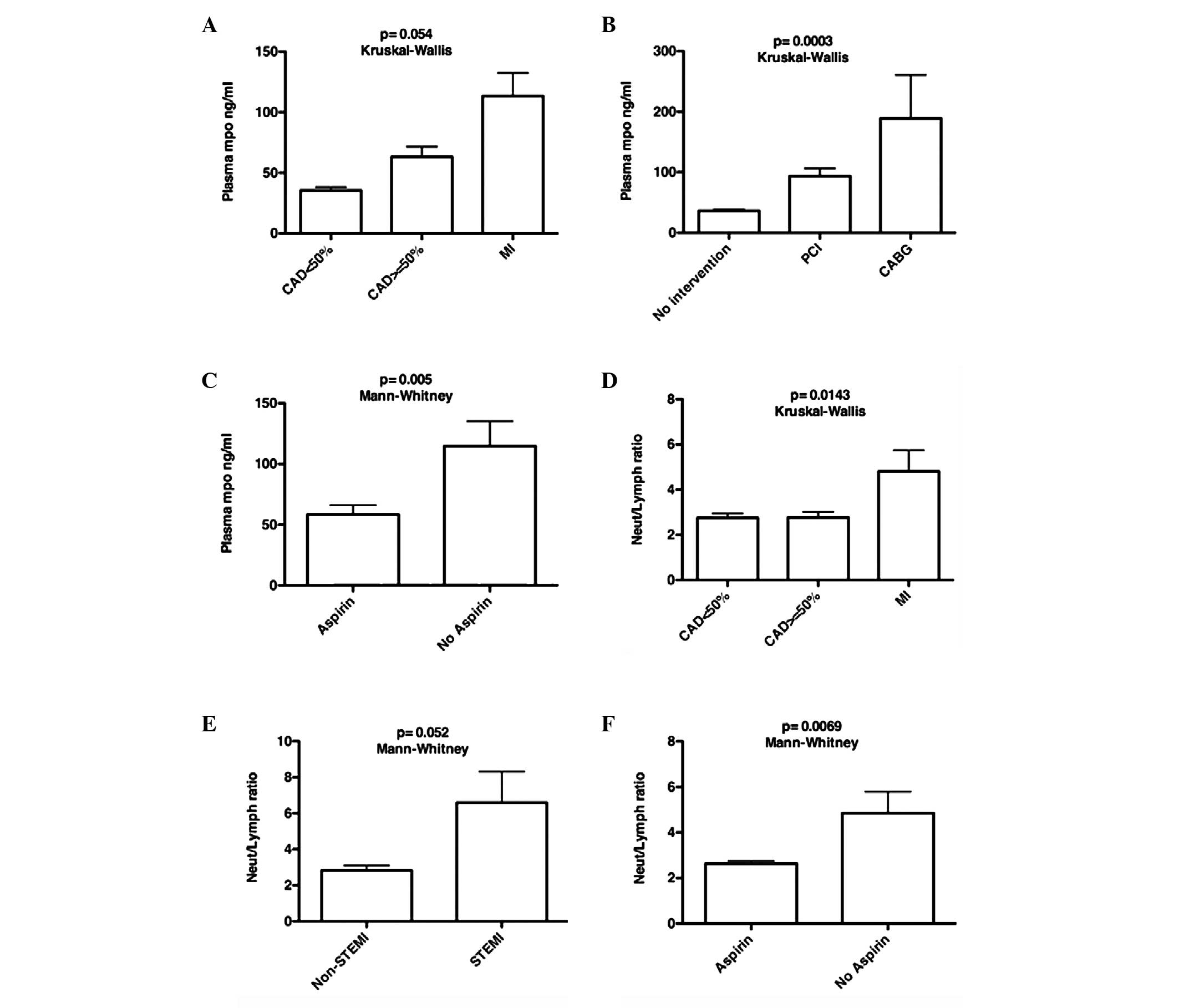|
1
|
Fitchett DH, Theroux P, Brophy JM, et al:
Assessment and management of acute coronary syndromes (ACS): a
Canadian perspective on current guideline-recommended treatment -
part 2: ST-segment elevation myocardial infarction. Can J Cardiol.
27(Suppl A): S402–S412. 2011. View Article : Google Scholar
|
|
2
|
Duivenvoorden R, Mani V, Woodward M, et
al: Relationship of serum inflammatory biomarkers with plaque
inflammation assessed by FDG PET/CT: the dal-PLAQUE study. JACC
Cardiovasc Imaging. 6:1087–1094. 2013. View Article : Google Scholar : PubMed/NCBI
|
|
3
|
Naruko T, Ueda M, Haze K, et al:
Neutrophil infiltration of culprit lesions in acute coronary
syndromes. Circulation. 106:2894–2900. 2002. View Article : Google Scholar : PubMed/NCBI
|
|
4
|
van der Wal AC, Becker AE, van der Loos CM
and Das PK: Site of intimal rupture or erosion of thrombosed
coronary atherosclerotic plaques is characterized by an
inflammatory process irrespective of the dominant plaque
morphology. Circulation. 89:36–44. 1994.
|
|
5
|
Mauriello A, Sangiorgi G, Fratoni S, et
al: Diffuse and active inflammation occurs in both vulnerable and
stable plaques of the entire coronary tree: a histopathologic study
of patients dying of acute myocardial infarction. J Am Coll
Cardiol. 45:1585–1593. 2005. View Article : Google Scholar
|
|
6
|
Kaya MG, Akpek M, Lam YY, et al:
Prognostic value of neutrophil/lymphocyte ratio in patients with
ST-elevated myocardial infarction undergoing primary coronary
intervention: a prospective, multicenter study. Int J Cardiol.
168:1154–1159. 2013. View Article : Google Scholar
|
|
7
|
Danesh J, Wheeler JG, Hirschfield GM, et
al: C-reactive protein and other circulating markers of
inflammation in the prediction of coronary heart disease. N Engl J
Med. 350:1387–1397. 2004. View Article : Google Scholar : PubMed/NCBI
|
|
8
|
Zhang R, Brennan ML, Shen Z, et al:
Myeloperoxidase functions as a major enzymatic catalyst for
initiation of lipid peroxidation at sites of inflammation. J Biol
Chem. 277:46116–46122. 2002. View Article : Google Scholar : PubMed/NCBI
|
|
9
|
Podrez EA, Schmitt D, Hoff HF and Hazen
SL: Myeloperoxidase-generated reactive nitrogen species convert LDL
into an atherogenic form in vitro. J Clin Invest. 103:1547–1560.
1999. View
Article : Google Scholar : PubMed/NCBI
|
|
10
|
Zheng L, Nukuna B, Brennan ML, et al:
Apolipoprotein A-I is a selective target for
myeloperoxidase-catalyzed oxidation and functional impairment in
subjects with cardiovascular disease. J Clin Invest. 114:529–541.
2004. View Article : Google Scholar : PubMed/NCBI
|
|
11
|
Vita JA and Loscalzo J: Shouldering the
risk factor burden: infection, atherosclerosis, and the vascular
endothelium. Circulation. 106:164–166. 2002. View Article : Google Scholar : PubMed/NCBI
|
|
12
|
Sugiyama S, Kugiyama K, Aikawa M, et al:
Hypochlorous acid, a macrophage product, induces endothelial
apoptosis and tissue factor expression: involvement of
myeloperoxidase-mediated oxidant in plaque erosion and
thrombogenesis. Arterioscler Thromb Vasc Biol. 24:1309–1314. 2004.
View Article : Google Scholar
|
|
13
|
Tang WH, Wu Y, Nicholls SJ and Hazen SL:
Plasma myeloperoxidase predicts incident cardiovascular risks in
stable patients undergoing medical management for coronary artery
disease. Clin Chem. 57:33–39. 2011. View Article : Google Scholar
|
|
14
|
Proposal for the multinational monitoring
of trends and determinants in cardiovascular disease and protocol
(MONICA Project). WHO/MNC/821. Cardiovascular Disease Unit, World
Health Organization; Geneva: 1982
|
|
15
|
Cavusoglu E, Ruwende C, Eng C, et al:
Usefulness of baseline plasma myeloperoxidase levels as an
independent predictor of myocardial infarction at two years in
patients presenting with acute coronary syndrome. Am J Cardiol.
99:1364–1368. 2007.
|
|
16
|
Zhang R, Brennan ML, Fu X, et al:
Association between myeloperoxidase levels and risk of coronary
artery disease. JAMA. 286:2136–2142. 2001. View Article : Google Scholar : PubMed/NCBI
|
|
17
|
Baldus S, Heeschen C, Meinertz T, et al;
CAPTURE Investigators. Myeloperoxidase serum levels predict risk in
patients with acute coronary syndromes. Circulation. 108:1440–1445.
2003. View Article : Google Scholar : PubMed/NCBI
|
|
18
|
Chang LT, Chua S, Sheu JJ, et al: Level
and prognostic value of serum myeloperoxidase in patients with
acute myocardial infarction undergoing primary percutaneous
coronary intervention. Circ J. 73:726–731. 2009. View Article : Google Scholar
|
|
19
|
Dominguez-Rodriguez A, Samimi-Fard S,
Abreu-Gonzalez P, Garcia-Gonzalez MJ and Kaski JC: Prognostic value
of admission myeloperoxidase levels in patients with ST-segment
elevation myocardial infarction and cardiogenic shock. Am J
Cardiol. 101:1537–1540. 2008. View Article : Google Scholar : PubMed/NCBI
|
|
20
|
Kaya MG, Yalcin R, Okyay K, et al:
Potential role of plasma myeloperoxidase level in predicting
long-term outcome of acute myocardial infarction. Tex Heart Inst J.
39:500–506. 2012.PubMed/NCBI
|
|
21
|
Miura T: Direction of strategic use: a new
classification of non-steroidal anti-inflammatory drugs based on
reactivity with peroxidase. Yakugaku Zasshi. 133:681–689. 2013.(In
Japanese).
|
|
22
|
Coimbra LS, Steffens JP, Muscará MN, Rossa
C Jr and Spolidorio LC: Antiplatelet drugs reduce the
immunoinflammatory response in a rat model of periodontal disease.
J Periodontal Res. 2013.PubMed/NCBI
|
|
23
|
Eickmeier O, Seki H, Haworth O, et al:
Aspirin-triggered resolvin D1 reduces mucosal inflammation and
promotes resolution in a murine model of acute lung injury. Mucosal
Immunol. 6:256–266. 2013. View Article : Google Scholar : PubMed/NCBI
|
|
24
|
King M, Kingery JE and Casey B: Diagnosis
and evaluation of heart failure. Am Fam Physician. 85:1161–1168.
2012.
|
|
25
|
Brügger-Andersen T, Hetland Ø, Ponitz V,
Grundt H and Nilsen DW: The effect of primary percutaneous coronary
intervention as compared to tenecteplase on myeloperoxidase,
pregnancy-associated plasma protein A, soluble fibrin and D-dimer
in acute myocardial infarction. Thromb Res. 119:415–421. 2007.
|











